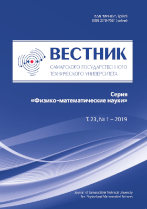|
Short Communication
Mechanics of Solids
Identification of the parameters of a rod with a longitudinal
rectangular groove using two spectra of natural frequencies
of bending vibrations
I. М. Utyasheva, A. F. Fatkhelislamovb
a Mavlyutov Institute of Mechanics, Ufa Centre RAS,
Ufa, 450054, Russian Federation
b Ufa University of Science and Technology,
Ufa, 450076, Russian Federation
(published under the terms of the Creative Commons Attribution 4.0 International License)
Abstract:
The inverse coefficient problem involves determining the geometric parameters of a longitudinal rectangular groove based on the natural frequencies of the bending vibrations of a rectangular rod. It is assumed that the groove does not extend along the entire length of the rod, but rather from a certain point to the right end. To solve the problem, the rod with the longitudinal groove is modeled as two sections: the first section without a groove and the second section with a groove.
Mating conditions are applied at the connection point, where deflection values, rotation angles, bending moments, and shear forces are equated. The behavior of the natural frequencies of bending vibrations when changing the length of the groove was investigated. A solution method is proposed that allows for determining the required parameters based on a finite number of natural frequencies of bending vibrations. It is shown that the solution is unambiguous when using frequency spectra with respect to mutually perpendicular axes.
Keywords:
bending vibrations, natural frequency, longitudinal groove, inverse problem, moment of inertia, error estimation, rectangular rod
Received: September 8, 2023
Revised: October 31, 2023
Accepted: November 1, 2023
First online: September 19, 2024
Citation:
I. М. Utyashev, A. F. Fatkhelislamov, “Identification of the parameters of a rod with a longitudinal
rectangular groove using two spectra of natural frequencies
of bending vibrations”, Vestn. Samar. Gos. Tekhn. Univ., Ser. Fiz.-Mat. Nauki [J. Samara State Tech. Univ., Ser. Phys. Math. Sci.], 28:2 (2024), 378–389
Linking options:
https://www.mathnet.ru/eng/vsgtu2061 https://www.mathnet.ru/eng/vsgtu/v228/i2/p378
|

|




 Contact us:
Contact us: Terms of Use
Terms of Use
 Registration to the website
Registration to the website Logotypes
Logotypes









 Citation in format
Citation in format 